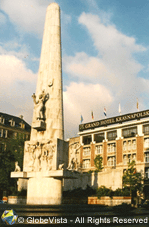National Monument Amsterdam

Public Art: National Monument Amsterdam
Also known as: Nationaal Monument or Nationaal Monument op de Dam
Sculptors: © Sculptures are by John Radecker and his sons Han and Jan Willem Radecker. The reliefs by sculptor Paul Gregoire.
Architect: J.J.P. Oud
Description: The World War II monument is a 22m high concrete conical pillar covered by white travertine stone. On the front side is a relief entitled De Vrede (“Peace”) which shows 4 chained male figures symbolizing the suffering of soldiers during the war. On either side of the relief are two male sculptures, the one on the left representing the resistance by the intelligentsia and the one on the right representing the resistance by the working classes. At their feet are dogs weeping. Above the central relief is a woman with a child in her arms and doves flying above her, symbolic of victory and peace. At the back of the monument is a relief showing doves flying towards the sky, symbolic of freedom. on either side of the monument are two lions symbolizing the Netherlands. The semicircular wall encompassing the monument contains 11 urns which hold soil from World War II execution grounds and war cemeteries in each of the Dutch provinces. A 12th urn was added later and it contains soil from the Dutch East Indies (now Indonesia).
Date Unveiled: The National Monument was unveiled on 4th May 1956 by Queen Juliana of the Netherlands.
Inscription :
“Hic ubi cor patriae monumentum cordibus intus
quod gestant cives spectet ad astra dei.”
Loosely translated …
“Here, where the heart of the fatherland is, may this monument, which citizens carry in their heart, gaze at God’s stars”
Location: The obelisk is located in Dam Square in Amsterdam, Netherlands.
Background to Amsterdam’s National Monument: Prior to the erecting of the present National Monument there was another monument called the De Eendacht (also known as Naatje van de Dam) commemorating the Ten Days’ Campaign in Dam Square. When World War II ended in 1945 a liberty pole was erected at the square with the Government promising a permanent national monument would soon be built. In the meantime, a temporary monument by A.J. van de Steur and Auke Komter was erected in 1947. This monument consisted of the 11 urns which, three years later became 12 urns after an additional urn with soil from the Dutch East Indies was added (now incorporated into the wall).
John Radecker won the commission to design the new national monument, and in 1946 his designs were exhibited at the Stedelijk Museum. The final design was approved by the Dutch government in 1952 but by then Radecker was in declining health. He would die four months before its completion leaving his sons Hans and Jan Willem to complete the project with architect J.J.P Oud.
Trivia:
During the 1960s and 70s the National Monument became a hang out for hippies. Every night you would find a considerably large group of hippies sleeping around the monument in sleeping bags which became known as Damslapen (“Dam-sleeping”). Chill man, it was the symbol of liberty!
On the 24th of August 1970, the municipal government announced they were banning Damslapen. As you can imagine the hippies weren’t happy and suddenly authorities had a riot on their hands. The rebellion went all night until off-duty marines appeared the next day to clear them out. The hippies decided not to return but instead relocate to Vondelpark.
The monument has had two considerable restorations, one in 1965 and then 1997-98. In the later restoration, the entire structure was dismantled and the brick interior of the central pillar was replaced by concrete. How’s that for trivia?